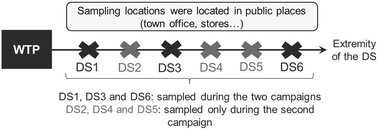Decision-making scheme for disinfection by-product monitoring intended for small drinking water systems†
Abstract
Trihalomethanes (THMs) and haloacetic acids (HAAs) are the most prevalent disinfection by-products (DBPs) in drinking water and their occurrence is regulated in several countries. However, most DBPs are not regulated, even though some may have greater toxicological relevance than regulated DBPs. Small water systems (SWS) supplied by surface waters are vulnerable to high levels of DBPs due, primarily, to a lack of adequate treatment processes that remove DBP precursors. Moreover, monitoring DBPs is difficult for SWS because it requires good knowledge of the system and qualified operators to select locations and periods for sampling. In view of the above, this study focuses on the development of a decision-making scheme for DBP monitoring in SWS, for the appropriate identification of periods and locations for DBP sampling. The study is based on information generated in 25 small systems in Canada. The following DBPs were considered: four THMs, five HAAs, four haloacetonitriles, two haloketones and one halonitromethane. The comparison of various sampling scenarios that took account of the temporal variability of DBPs served to identify appropriate periods for DBP sampling. Residual chlorine demand was used as an indicator of the spatial variability of DBPs in order to identify appropriate locations for sampling. This decision-making scheme provides SWS operators with a high cost-benefit tool for decision making to select sampling periods and locations in order to comply with current regulations concerning THMs and HAAs (and eventual future regulations for non-regulated DBPs).



 Please wait while we load your content...
Please wait while we load your content...